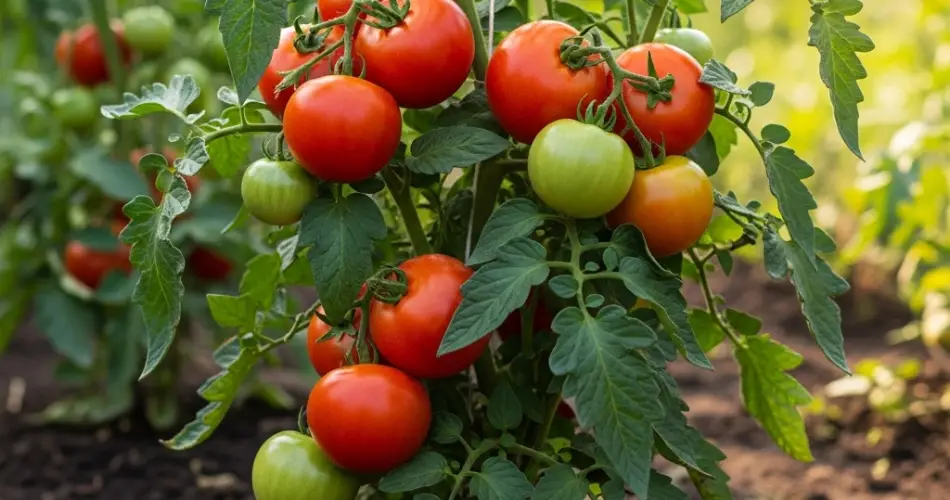Feeding your tomato plants properly can make the difference between a modest harvest and a season full of juicy, flavorful fruits. Tomatoes are heavy feeders and require consistent nourishment throughout their life cycle. Following a structured feeding schedule ensures your plants grow vigorously, produce high yields, and remain resistant to diseases. Here’s a comprehensive guide to a feeding schedule that truly delivers results.
1. Before Planting: Prepare the Soil
Your feeding schedule starts even before the tomato plants go into the ground. Tomatoes thrive in nutrient-rich, well-draining soil.
-
Incorporate compost: Mix in well-rotted compost or aged manure to improve soil texture and fertility.
-
Add a balanced organic fertilizer: Use a slow-release fertilizer with equal parts nitrogen (N), phosphorus (P), and potassium (K), such as a 10-10-10 mix. This provides a good nutrient foundation.
-
Check the pH: Tomatoes prefer slightly acidic soil, ideally between 6.0 and 6.8. Add lime if the soil is too acidic or sulfur if it’s too alkaline.
2. At Planting Time
When transplanting seedlings into your garden or containers, add an extra boost to encourage strong root development.
-
Use bone meal or rock phosphate: Place a tablespoon at the bottom of each planting hole to support root and flower formation.
-
Include Epsom salt: Add a teaspoon to each hole to provide magnesium, which supports chlorophyll production and nutrient absorption.
After planting, water the plants well and mulch around the base to retain moisture and reduce weed growth.
3. Early Growth Stage (Weeks 1–3 After Planting)
During the early stages, tomato plants focus on building a strong root system and leafy growth.
-
Apply a high-nitrogen fertilizer: Use a liquid fish emulsion or seaweed extract every 10–14 days to support healthy leaf development.
-
Be careful not to overfeed: Excess nitrogen can delay flowering and fruiting.
Continue watering consistently, aiming for deep watering rather than frequent, shallow sessions. This promotes deeper roots.
4. Pre-Flowering Stage (Weeks 4–5)
As plants mature and start forming flower buds, they need more phosphorus and potassium.
-
Switch to a bloom-boosting fertilizer: Use a blend like 5-10-10 or similar to encourage flowering over leaf production.
-
Use compost tea: Apply compost tea weekly to supply micronutrients and boost microbial life in the soil.
Staking or caging your plants at this stage also prevents damage and allows better airflow.
5. Flowering and Fruit-Setting Stage (Weeks 6–9)
This is a critical period when plants begin flowering and developing small fruits.
-
Feed with tomato-specific fertilizer: These blends typically contain higher potassium (K) and lower nitrogen (N). Apply every two weeks.
-
Top-dress with compost: Add a layer of compost around the base of each plant to provide a steady nutrient release.
-
Calcium support: To prevent blossom-end rot, apply crushed eggshells or a calcium-rich foliar spray if your soil lacks calcium.
Ensure even watering during this phase—fluctuations in moisture can lead to cracking or blossom-end rot.
6. Fruit Development and Ripening Stage (Weeks 10+)
At this point, your plant’s focus is entirely on fruit development. A steady supply of potassium helps fruits ripen fully and taste great.
-
Continue potassium-rich feedings: Apply liquid kelp or a low-nitrogen fertilizer every two weeks.
-
Side-dress with wood ash or greensand: These natural sources of potassium can improve fruit quality.
Reduce watering slightly as the fruits start to ripen—this helps concentrate flavor and prevent splitting.
7. General Tips for Success
-
Observe your plants: Yellowing leaves, curling tips, or poor fruiting may indicate nutrient imbalance.
-
Avoid overfeeding: Too much fertilizer can burn roots or cause excessive leaf growth at the expense of fruit.
-
Use mulch generously: Organic mulch like straw or chopped leaves keeps roots cool and nutrient levels steady.
-
Don’t forget micronutrients: Zinc, magnesium, and calcium are vital. Compost, kelp meal, and rock dust help supply these.
By following this tomato feeding schedule, you give your plants exactly what they need at each stage of growth. Healthy, well-fed plants are more productive, more resistant to pests and diseases, and more likely to reward you with a bountiful harvest. Whether you’re growing in containers or garden beds, this balanced approach will help ensure juicy, flavorful tomatoes all season long.



